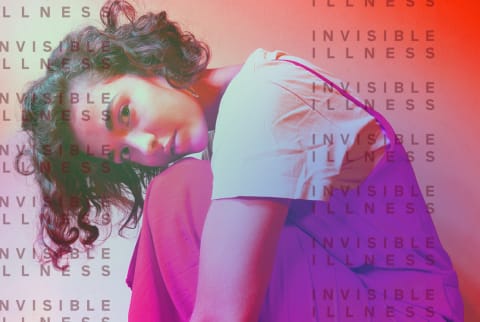Advertisement
I Was Finally Diagnosed With Bipolar Disorder After Six Incorrect Identifications


Trigger warning: This article includes mentions of suicidal ideation.
On too cold a fall morning to be outside for long, I sat on a bench on the Pedestrian Mall. The cold made my teeth chatter. The outdoor promenade, where students and residents often crowded, was empty of people. Tears streamed down my cheeks. I hovered near hysterics. Then fell into them.
The suicidal thoughts came regularly and then often. The usual: I can't do this anymore, this is never going to end, I want to die. They were strongest not at night but midmorning and in the afternoon, often at the campus recreation center after I'd spent an hour on a stair machine or treadmill trying to sweat them away.
I stopped crying long enough to go to my appointment with my therapist, Angela. I'd been seeing her since the depression diagnosis from Dr. B. People said people with depression needed therapy, so I went. The crying, she'd witnessed; the suicidal thoughts, she knew nothing about.
She was young with smiling eyes and a voice that reminded me of a cooing dove. I sat in the client's chair, she opposite me in her desk chair. After some time (therapists like to let you cry), she asked me to talk about it, if I could.
"Nothing's wrong," I said. "That's what I don't understand." I'd passed my dissertation defense. I wasn't sad about Ray anymore.
She asked what else might be causing me to feel the way I did.
The crying started again. It seemed not to come from me. Then I seemed not to be myself, watching myself in the chair and Angela across from me. I said I didn't want to be there anymore.
Angela clarified: "Where? Here? In the office or...?"
I tried to answer but couldn't. Heaves. Sobs. Ridiculous.
"Have you had these thoughts before?" she asked.
I said I had.
Our session ended. She made me promise to call every day to check in until our next appointment. "I'm responsible for you."
I went to class. I taught. I ran. I wrote. I walked. I ate. I called and checked in.
At my next appointment, Angela asked how I was doing.
"Worse," I said.
She stood and in a gentle voice said she'd be right back. "Don't go anywhere."
I started to cry again.
Angela returned. "We're lucky she's free."
"Who?"
Angela led me down the hall to the office of the psychiatrist in her practice. The psychiatrist's office was painted teal. In her 50s, the psychiatrist had long brown hair and wore a suit jacket, a skirt, and heels. She introduced herself though I can't remember her name.
I sat on the couch. Angela stayed in the room. From the psychiatrist's mouth came questions I tried to answer. I measured my words, modulating my voice so that the words didn't sound alarming. It backfired, and I devolved into hysterics more extreme than if I'd let myself cry.
The psychiatrist smoothed her skirt and stood. "I think you should see one of my colleagues." She went to the phone on her desk.
"Who?" I asked, panic in my voice.
The psychiatrist didn't answer.
I looked at Angela, whose dove eyes had in them only sympathy.
When the psychiatrist hung up, she said, "We can go."
"Where?" I asked.
My experience at an inpatient psychiatric ward.
She and Angela drove me to a private hospital called Mercy. (The irony of the name was lost on me at the time.) I was being escorted—that was clear. An image of my mother and me in the cab on the way to the eating disorders unit so long ago came to me. I was scared. I wanted to ask if I'd be able to go home that night. We entered the hospital's locked inpatient psychiatric ward. The psychiatrist and Angela led me to the receptionist.
"Am I being checked in?"
The psychiatrist said, "You'll see someone and decide together."
She and Angela said goodbye. The psychiatrist was all business. Angela looked worried and a little relieved.
I was shown to the day room with the other patients. It had none of the melodrama usually imparted to "psych wards" in movies and in books. The TV on the wall was muted. Four guys sat at a table playing cards. They didn't even look depressed.
On a side table were coffee and tea. The hospital must always have been that calm if the staff didn't worry about anyone throwing hot liquid on them or each other, I thought. The room was so quiet that for a moment I wanted to stay.
The room I was assigned had two beds. Panic filled me. "Am I going to have a roommate?" I asked the nurse. It wasn't a hotel moment. I wasn't telling the management the room didn't please me. Sleeping in a room with someone in the same space—with the world so unreal and me disappearing—was impossible. I'd crack for good.
The nurse offered me a benzodiazepine.
"Valium?" I asked.
"Alprazolam." When I didn't respond, she smiled. "Xanax."
"I don't want that. Can I see the doctor?"
After she was gone, I sat on the bed. The thoughts of suicide seemed so irrelevant now that I was being faced with a locked ward. Were they really that serious? They had to be. I was bipolar.
Why it's so hard to get a proper mental health diagnosis.
The lack of validity of DSM diagnoses and its unstable symptom lists produce statistics that are concerning and absurd. They don't actually tell us the number of Americans with mental disorders; all the statistics really say is that 26% or 21% (or whatever percentage you want to believe) of American adults receive an invalid, likely unreliable, invented DSM diagnosis (or two) each year.
These statistics are batted about by the media and mental health organizations and on social media as if they're legitimate. Never mind that the diagnoses aren't provable, the statistics don't take the severity of disability into account. The DSM-5 doesn't assess the level of impairment. Depression is depression. Someone with five of nine symptoms has the same diagnosis as someone with all nine. Being a little down is the same as being so depressed as to be suicidal. As others have pointed out, that's like treating a patient with Stage 1 cancer the same as one with Stage 4 cancer that's metastasized. The DSM only perfunctorily takes the degree and severity of a person's suffering into account.
More compelling statistics come from the NIMH, which at least distinguishes between the rates of any mental illness (AMI) and serious mental illness (SMI). Though some define serious mental illness by diagnosis (like bipolar, schizophrenia, and treatment-resistant depression), the NIMH defines it as "serious functional impairment." At least the NIMH's rates of mental illness are more discerning: Although 20% of American adults reported any diagnosis (AMI), only 5% had a serious mental illness (SMI).
Regardless, the numbers, like the diagnoses, are skewed. How can so many people have DSM diagnoses? The DSM has made it so.
Adapted excerpt from PATHOLOGICAL: The True Story of Six Misdiagnoses by Sarah Fay. Reprinted with permission from HarperOne, an imprint of HarperCollins Publishers. Copyright © 2022.

Eating Enough Of This May Better Preserve Your Memory With Age
Molly Knudsen, M.S., RDN

7 Unexpected Things That Happen When You Practice Self-Love Daily
Tanya Carroll Richardson

Eating Enough Of This May Better Preserve Your Memory With Age
Molly Knudsen, M.S., RDN

7 Unexpected Things That Happen When You Practice Self-Love Daily
Tanya Carroll Richardson

Eating Enough Of This May Better Preserve Your Memory With Age
Molly Knudsen, M.S., RDN

7 Unexpected Things That Happen When You Practice Self-Love Daily
Tanya Carroll Richardson

Eating Enough Of This May Better Preserve Your Memory With Age
Molly Knudsen, M.S., RDN

7 Unexpected Things That Happen When You Practice Self-Love Daily
Tanya Carroll Richardson














